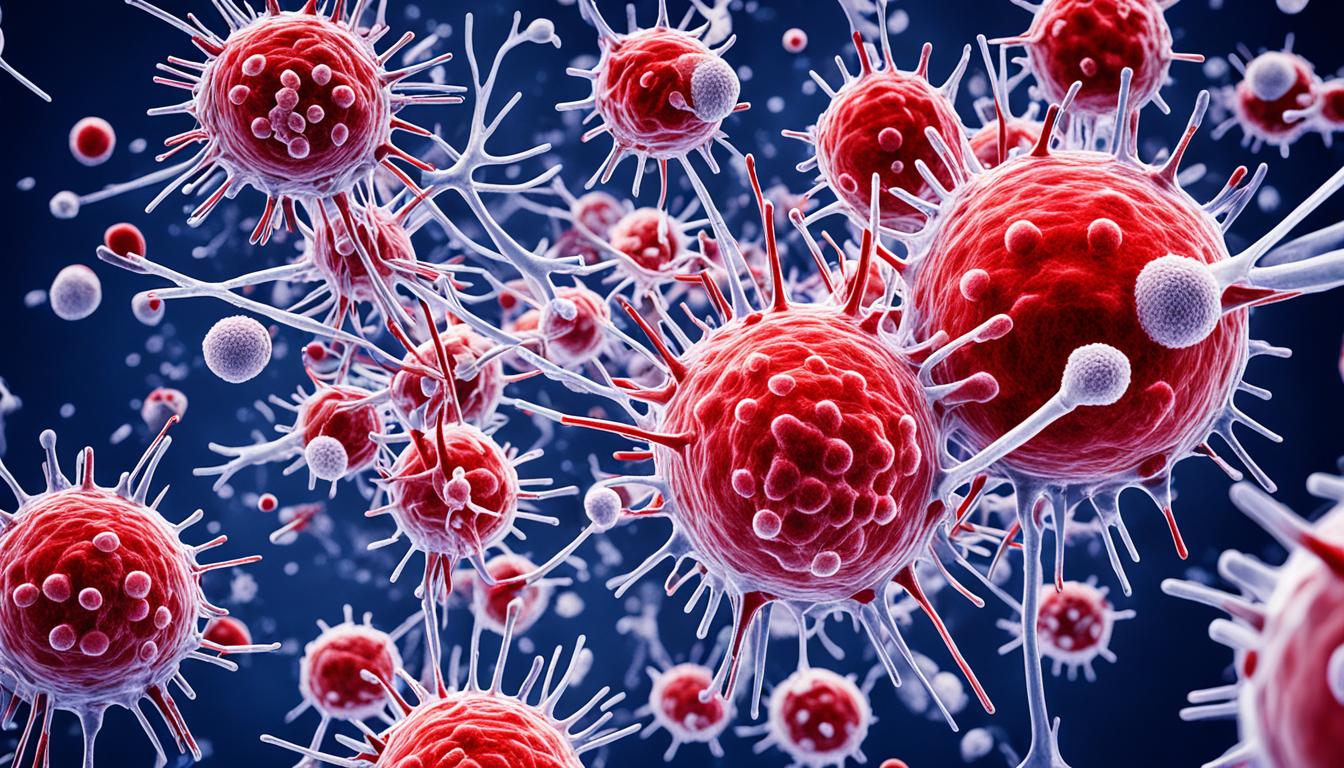Leukemia hairy cell disease, or hairy cell leukemia, is a rare form of leukemia in adults. It makes up about 2% of adult leukemia cases. This type of cancer starts in the bone marrow’s B lymphocytes. It grows slowly over time.
Its symptoms include feeling very tired, getting sick often, having a big spleen, and unusual blood counts. We don’t yet know what causes hairy cell leukemia. It’s more common in men than in women.
Key Takeaways:
- Leukemia hairy cell disease, or hairy cell leukemia, is a rare form of adult leukemia.
- It primarily affects the B lymphocytes in the bone marrow.
- Common symptoms include fatigue, increased susceptibility to infections, enlarged spleen, and abnormal blood counts.
- The exact cause of hairy cell leukemia is unknown.
- Hairy cell leukemia primarily affects adults, with a higher incidence in men.
Watchful Waiting and Late Effects of Hairy Cell Leukemia
In cases with no symptoms, doctors often use watchful waiting for hairy cell leukemia. They schedule regular check-ups. This lets them keep a close eye on the disease’s progress. If symptoms show up, the doctor will start treatment customized for the patient.
During watchful waiting, doctors check blood counts and other key signs regularly. This keeps them ready to start treatment fast if needed. It helps keep the disease from affecting the patient’s health too much.
After treatment ends, some people might not face any more health issues. But, others might experience late effects. These can include problems with past treatment or even new cancers.
Doctors should talk openly with patients about possible late effects. They need to carefully monitor and manage any long-term effects on health.
Common Late Effects of Hairy Cell Leukemia Treatment
| Late Effects | Explanation |
|---|---|
| Secondary Cancers | Some patients may develop secondary cancers as a result of previous treatments. |
| Cardiovascular Issues | Treatment for hairy cell leukemia can potentially affect the heart and blood vessels, leading to cardiovascular complications. |
| Hormonal Imbalances | Some treatments may disrupt hormone production and cause hormonal imbalances in the body. |
| Infertility | Chemotherapy and radiation therapy can impact fertility in both men and women. |
| Chronic Fatigue | Many individuals may experience persistent fatigue even after completing treatment for hairy cell leukemia. |
Diagnosis and Symptoms of Hairy Cell Leukemia
Diagnosing hairy cell leukemia involves many steps. A doctor will first check you for an enlarged spleen. Thanks to more blood tests used, this sign is seen less often now. A CBC test shows blood cell counts. And a blood smear lets doctors spot hairy cells through a microscope. Other tests like immunophenotyping, a bone marrow biopsy, or imaging may also be done.
If you have hairy cell leukemia, you might feel very tired. You could also bleed or bruise easily. Getting sick a lot, finding it hard to breathe, or losing weight are warning signs. And some might feel pain or a tightness in the stomach.
Finding the condition early is key to treating it. Blood tests are usually the first step. They can show if your blood cell counts are off. A CBC sees if levels of cells like red or white blood cells are normal.
A peripheral blood smear is very important too. It’s a simple test where blood is looked at under a microscope. Doctors can then spot those unique hairy cells. They are called hairy cells because they look like they have hair under the microscope.
Immunophenotyping is a way to identify cancer cells by their outer proteins. It is used to tell hairy cell leukemia apart from other types. Specific markers on these cells help confirm the diagnosis.
Sometimes, a bone marrow biopsy is needed to be sure of the diagnosis. Bone marrow is sampled from the hip bone or sternum. This is done with a needle in a quick and mostly painless way. Doctors then look at the sample to find hairy cells.
Ultrasounds or CAT scans might also be done. They check the spleen’s size and look for problems in the nearby organs.
Knowing the signs of hairy cell leukemia can help with quick treatment. If you feel very tired, bleed a lot, or get sick often, tell your doctor. Unintentional weight loss or stomach pain are other signs to watch for.
Treatment Options and Support for Hairy Cell Leukemia
Treating hairy cell leukemia aims to manage the disease well and enhance patients’ quality of life. The right treatment is chosen based on health, disease severity, and symptoms.
Options for treatment include chemotherapy, immunotherapy, and splenectomy. Chemotherapy uses strong medicines to kill cancer cells. Immunotherapy boosts the immune system to fight the leukemia cells. Surgery, like removing the spleen (splenectomy), can also help reduce symptoms.
After starting treatment, regular check-ups and blood tests are key. This tracks how well the treatment is working and any side effects. The outlook for patients with hairy cell leukemia is usually good thanks to high survival rates. Continuing with medical care and a healthy lifestyle is very important for long-term health.
Support can also come from groups and resources that help with both emotions and practical needs for those with the disease. These help provide a caring environment where patients and their families can connect, share stories, get advice, and learn more about the condition. This support assists in tackling the disease’s challenges and offers comfort through shared experiences.

